Exciting times in the Audit office. I’ve been joined by Louise – pictured above – my new intern!
If she can bear it, in between finishing her design degree Louise will be helping me out on some of the trickier aspects of my work at the MCA.
The first of her tasks, early last week, was to assist me with carrying out The Great MCA Third Floor Lighting Survey.
This was by no means an easy task. Nor was it the first attempt at such a survey. Nor is it yet finished. I’ll explain why…
The idea was that we would draw up a big map of the Third Floor of the museum – the level on which the In the Balance exhibition is housed. The map would show each and every room and all the artworks housed therein. We would then wander around the gallery, plonk ourselves on the floor in each room, and count all the light fixtures. Theoretically, upon completion of this task, we could multiply the amount of fixtures by the relative wattage of each one, and come up with an overall energy consumption figure for the entire exhibition.
I feel exhausted just thinking about it.
It’s the sort of job you’d want to get somebody else to do for you. And in fact, a few weeks ago, I did just that.
Here’s Zephyr, the youngest member of The Artist as Family carrying out the preliminary study for The Great Survey (Zephyr’s the short one in the foreground. The tall one is Chris, the MCA preparator):
On the day before he left to go back to Daylesford, Zephyr was wandering around the galleries looking like he needed a job. So I gave him a scrap of paper and a red pen and asked him to take note of all the lights in the show. If we peer over his shoulder we can see how he did it:
Each light has a different shape, and they’re kinda hard to describe in words (“the triangular ones”, the “cylindrical ones” etc) so we tried to draw a picture of each one that would be instantly recognisable.
Unfortunately, later on when I showed Zephyr’s handywork to Nikki (the MCA’s lighting guru) she looked crestfallen. “But I’ve changed the lights since he did that survey!”, she groaned.
Hence the need to do it all again… (and, on the upside, the chance to do it even more obsessively).
So… here’s a close-up of the bottom of the newly completed Survey Map, showing a small portion of the different types of lighting fixtures which are used to illuminate the show:
Once we started looking, we spotted the following:
 triangular lights (103)
triangular lights (103)
 cylindrical lights (53)
cylindrical lights (53)
 stubby cylindrical lights (4)
stubby cylindrical lights (4)
 funny “H” shaped swivelly lights (14)
funny “H” shaped swivelly lights (14)
 lights embedded flush with the ceiling (1)
lights embedded flush with the ceiling (1)
 green coloured exit lights (14)
green coloured exit lights (14)
 fluorescent tubes (50)
fluorescent tubes (50)
 long pointy directional lights (17)
long pointy directional lights (17)
 dangling-from-a-long-cord lights (9)
dangling-from-a-long-cord lights (9)
 cone-shaped lights (15)
cone-shaped lights (15)
— not to mention the following peripheral (and not-so-peripheral) electrickery:
 video projectors of various sorts (10)
video projectors of various sorts (10)
 large and small LCD screens (8) and plasma televisions (1)
large and small LCD screens (8) and plasma televisions (1)
 a laptop (1: mine)
a laptop (1: mine)
 some Macintosh computers connected to the internet (5)
some Macintosh computers connected to the internet (5)
 an electric whiteboard (1)
an electric whiteboard (1)
 motion sensors (18)
motion sensors (18)
 smoke alarms (21)
smoke alarms (21)
 amplifiers and speakers (18)
amplifiers and speakers (18)
 one photocopy machine and one printer (both in the library)
one photocopy machine and one printer (both in the library)
 closed-circuit television cameras (10)
closed-circuit television cameras (10)
 temperature and humidity sensors (2)
temperature and humidity sensors (2)
– and –
 unidentified electrical objects (5).
unidentified electrical objects (5).
Holy coal-fired power stations, Batman! Strap me in and throw the switch, we sure do seem to need a lotta technology to bring Art to the masses!
In fact, the only works in the show which don’t need the mediation of electricity in some form or another are Diego Bonetto’s Weed Cabinets (located adjacent to natural light crevices in the corners of the museum) which use sunshine to grow themselves. (To a lesser extent, you could also include Lauren Berkowitz’s plants in this category, as they live part of their lives soaking up the rays on an external balcony).
To take just one of the spaces in the show as a random sample: here’s the room where Jeanne Van Heesewijk and Paul Sixta have their amazing installation about the Goulburn Waste Processing operation (where Sydney sends over 60 truckloads-o-trash every day):
It seems from our chart that this room (which also houses a small display of a blog and some digital prints by The Artist as Family) needs 23 triangular lights and 5 cylindrical lights, as well as 3 computers and two smoke detectors (plus one flat screen TV – thanks to Paul for pointing this out in the comments below). If we average out the lights at about 100 watts per hour, and the computers plus the television at about 100 watts per hour each (I have no idea how much power a smoke detector uses, but I imagine it’s rather minor), that gives us roughly 3200 watts per hour, to power that one room. That’s a bit like running two of those horrid oil bar heaters all day in there.
Now, I have to re-state: the above figures are very rough. The next step for Louise and I would be to spend some time with Mark (the MCA’s audio-visual guru) and Nikki (the lighting maven I mentioned above) in order to obtain more precise figures for each particular fixture and electrical appliance…
Here’s the final chart, minus the calculations:
By the time this is all over, we should be able to work out something of a “total carbon emissions” (not counting air conditioning of course) for the third floor.
Won’t that please all you quantitative data-hungry fans out there!

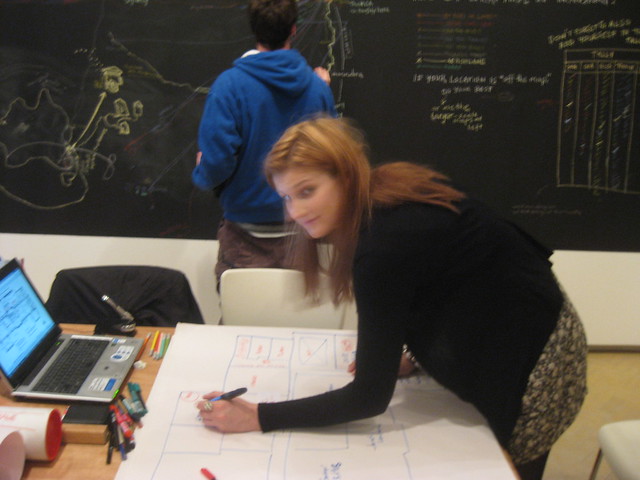
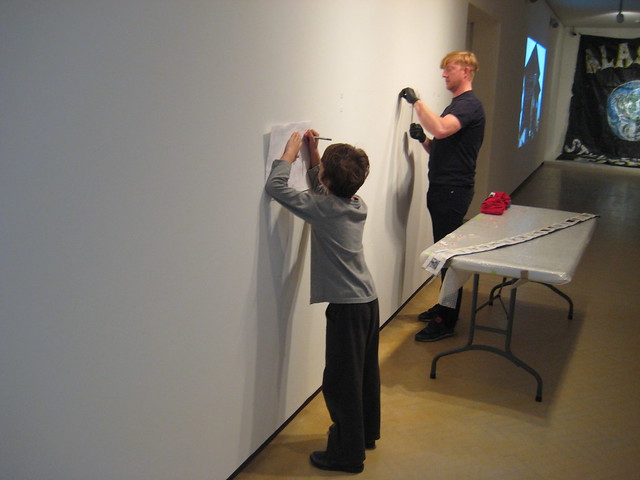
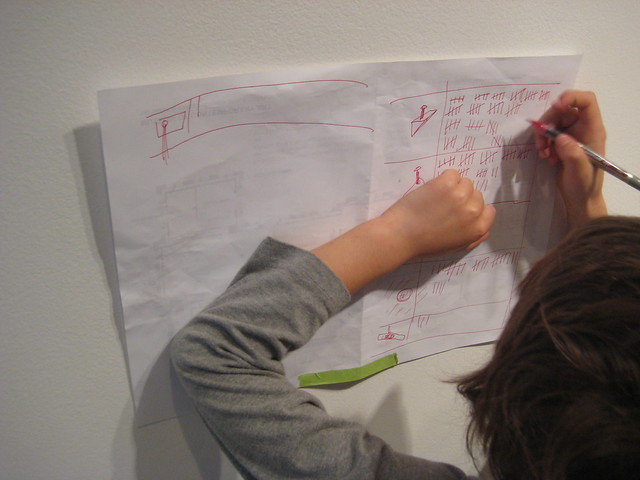

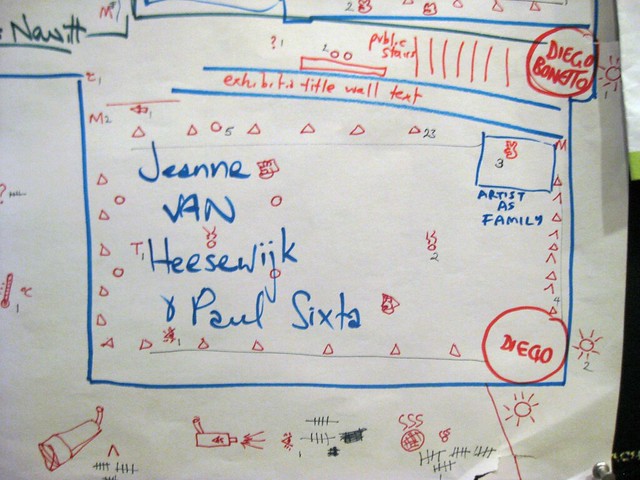
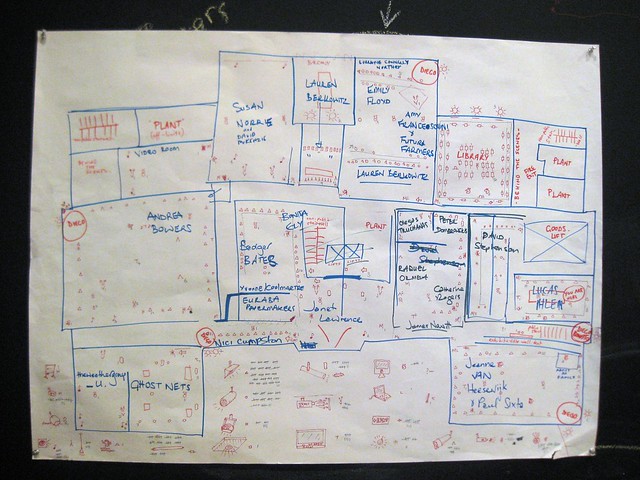
Note: the approximate computer power use figure was gleaned from here.
You’ve left out the flatscreen on the wall. no idea how much power that takes
Damn, thanks Paul. How’d we miss that? I’ll add it…
To do a lighting audit you better make sure you know what sort of light you are measuring to gauge energy consumption. If the lights are using compact fluro light they will use less energy than a halogen globe. A Fluro Battern will use less energy as well. You also better find out if the lights are dimmed, if they are they will again use lots less energy. Most of a lights energy is lost in heat, different lights and settings will give you different results. You also better find out if the Exit and Smoke alarms run on batteries or are connected to the main power supply. An audit of this complexity, really needs to be done by an engineer otherwise your results will be very unreliable.
Thanks Teo. Yep, it’s all part of the process!
I’m working with Mark the preparator to determine as many of these variables as we can. Naturally an engineer would do a better job than me, but that’s not going to stop me trying! Part of this project is about finding the limits of what the “layman” can do without being intimidated by the need for an expert.
It sounds like you know quite a lot about this stuff – let me know if you have any further tips.
cheers and thanks
Lucas
Wow, it sounds v. cool written up like that. It was an interesting exercise – hopefully we made up in enthusiasm what we lacked in technicality.
Indeed we did Louise! And the document already does seem to have some value as an explanatory tool pinned up in the gallery, regardless of the final emissions results…
I should add that there are big issues at stake in the quest to improve the lighting scenario.
From the above it should be obvious that the MCA is running on an “old fashioned” lighting system, rather than using new “energy saver” bulbs. The old fixtures can’t take the new-generation bulbs. You need to invest in new fixtures. But each new lighting fixture costs hundreds of dollars, so to replace the whole gallery’s lighting would be a massive expense. And yet that is what would be needed before the museum could begin saving money on its electricity bills (and of course, before it could reduce its carbon emissions too).
See the dilemma? Need to have money to save money.
I had a long chat with Tony, the preparator-boss about this today. I am hoping if he has time, he’ll chime in here with the fine details, as he’s really done some thorough thinking on all these matters. It seems that “the market” for new generation LCD lighting is moving rapidly, and within a year or so there will be some high-performing, not too expensive options available…
woo louise!!! good to see you today!!!